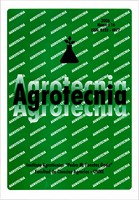Efecto biostimulante de Trichoderma atroviride en zapallo anco (Cucurbita moschata Duch. ex Poir)
DOI:
https://doi.org/10.30972/agr.0326336Palabras clave:
Promotores del crecimiento, Plantines, Cucurbitáceas, BiofertilizantesResumen
Se evaluó el efecto bioestimulante de Trichoderma atroviride en el crecimiento de plantines y rendimiento comercial de zapallo (Cucurbita moschata). La etapa de plantin se evaluó en invernadero y los tratamientos fueron T0: control -sin inocular-; T1: 200 ml.m-2 y T2: 500 ml.m-2 de T. atroviride SC 108 conidios. A los 30 días se evaluó: número de plantas; longitud radical; altura del plantín; número de hojas; peso fresco y seco aéreo y radical e índice raíz/aéreo. Se halló diferencias significativas para altura de plantín en T1 respecto de T0 y T2. La media del peso fresco aéreo fue significativamente superior en T1 respecto a T2. El peso fresco radical fue superior estadísticamente en T2 respecto al resto. Plantines tratados con dosis más alta de T. atroviride registraron aumento en masa radical, e índices raíz/aéreo próximos a 1. El resto de las variables no registraron diferencias estadísticas entre tratamientos y T0. A campo, los tratamientos fueron T0: sin inocular; T2 y T3 inoculados con 20 ml.m-2 y 50 ml.m-2 en etapa de plantin respectivamente, y adición de 3 l.ha-1 de T. atroviride SC 108 conidios al trasplante. Se cosechó 100, 108 y 115 días posteriores al trasplante (DPT). Se evaluó cantidad de plantas que prosperaron a cosecha, número y peso de frutos por planta. El T2 se diferenció significativamente superando a T0 y T1 en número de plantas a cosecha. El número de frutos no mostró diferencias significativas en las diferentes cosechas. No obstante, T2 evidenció mayor peso de frutos comerciales cosechados a los 108 DPT, dando una mayor precocidad.



